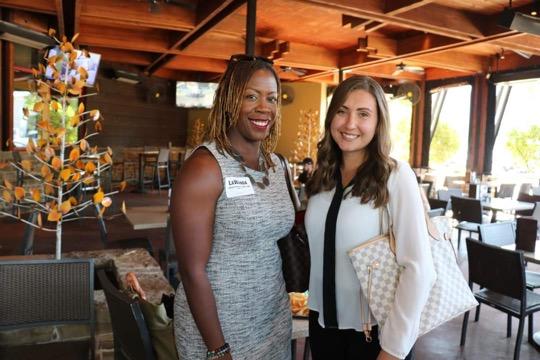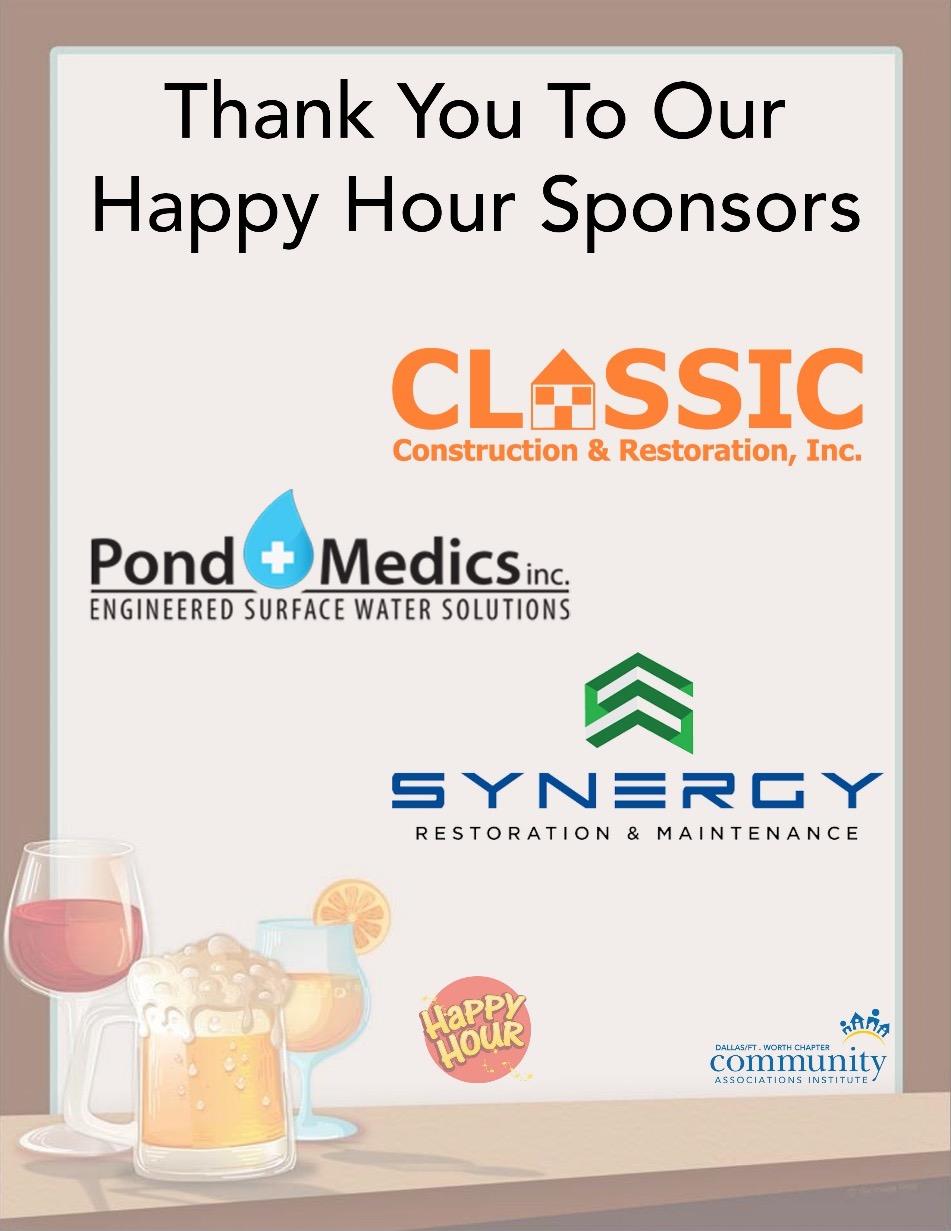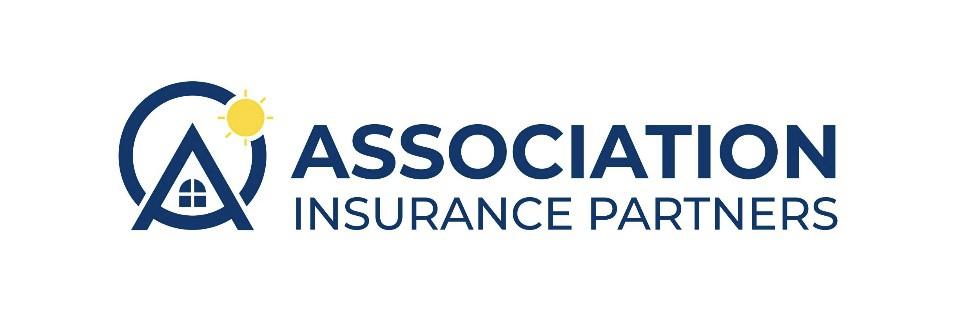
11 minute read
Happy Hour Recap



October 6, 2022 New Members Happy Hour
In October, our Membership Committee held the first New Members Happy Hour at Lazy Dog in Addison! Both new and seasoned members came together for an exciting afternoon of networking – and our newest members even got to “spin the wheel” for a chance to win a number of exciting prizes, from chocolates to duffle bags! We are looking forward to scheduling more of these events in the future, and hope you will join us next time! (Photos courtesy of chapter member Kevin Scroggins, Next Door Painting)



Innovating community association banking solutions is our business,

so you can focus on growing yours.
With a strong commitment to the community management industry, backed by sizable national resources, Alliance Association Bank provides an unmatched level of expertise and responsiveness. Our customer-focused approach means you get a dedicated, experienced relationship manager— a single point of contact—to help with your unique needs so you’re able to focus on what matters most: your business and your customers.
Specializing in:
No-Fee Lockbox Services1
ConnectLiveTM Software Integration
Full Online Banking Services2 Online Homeowner Payment Portal
Lending Solutions3
Extensive Deposit Solutions4
Meet Your Community Association Banking Experts:
Wendy Hazelwood, CMCA Vice President (214) 837-7711 whazelwood@allianceassociationbank.com
Joanne Haluska, CMCA, AMS Senior Managing Director, Central Region (216) 314-9100 jhaluska@allianceassociationbank.com
| allianceassociationbank.com
1Funds deposited through the Lockbox will follow Western Alliance Bank’s funds availability policy as outlined in the Deposit Account Agreement Disclosure. 2Fees may be imposed for additional services related to online banking. Refer to Business Online Banking Setup and Authorization for more information. 3All offers of credit are subject to credit approval, satisfactory legal documentation and regulatory compliance. 4Refer to the disclosures provided at account opening and the Schedule of Fees and Charges for additional information. Alliance Association Bank, a division of Western Alliance Bank, Member FDIC. Western Alliance Bank ranks high on the Forbes “Best Banks in America” list year after year.
Why Choose Alliance Association Bank:
Alliance Association Bank has over 50 years of combined experience meeting the unique and complex banking needs of community associations. This experience, combined with our financial strength and stability, make Alliance Association Bank a key financial institution to build an alliance with to grow your business. Alliance Association Bank is a division of Western Alliance Bank, Member FDIC. As one of the country’s top-performing banking companies, Western Alliance was #1 best-performing of the 50 largest public U.S. banks in the most recent S&P Global Market Intelligence listing and ranks high on the Forbes “Best Banks in America” list year after year.
One of Forbes’ Best Banks in America Year After Year
Managing the Risks of Fall and Winter Events

By: James L Shelby, CPCU, CIC | LaBarre/Oksnee Insurance
As cooler weather and the Holidays are approaching, many Community Associations will be planning events for their Owners. Fall Festivals, Hayrides and other Holiday gatherings can bring a community together, but there are risks that Associations should consider.
When planning an event, consider contacting your insurance provider to find out if an activity would be covered. For example, some insurance companies will not cover hayrides, inflatables (bounce houses), mechanical games, live animals (petting zoos) or other specific activities. If an activity will not be covered by the Association’s insurance, a Special Event policy may be an option. Special Event policies provide liability coverage for a specific event. The premium cost will depend on the type of event.
Whether an event is covered by the Association’s primary policy or a Special Event policy, the insurance company will expect the vendors to have liability and to name the Association as Additional Insured. There should be an agreement in place that requires the vendor to indemnify and defend the Association. The Association’s attorney can provide a standard agreement for vendors. If a vendor provides their own agreement, the Association attorney should review it prior to signing.
There are situations where Community Associations may want to provide alcohol at an event. The Liquor Liability exclusion does not normally apply if the insured is not in the business of selling alcohol, but some insurance companies may have more restrictive wording on their policies, and they typically do not like their insureds to serve alcohol. In addition to insurance considerations, a committee member or volunteer may not want to have to tell a friend or neighbor he or she has had enough or try to determine if someone is underage. If the Association contracts with a company with TABC trained servers to provide beverage service, that company can provide the Association with insurance protection and take on the liability associated with serving alcoholic beverages.
For many Community Associations, Fall may be a time to schedule a volunteer workday or have volunteers decorate common areas. What happens if a volunteer is injured while performing work for the Association? The Medical Payments portion of the Association’s General Liability policy may respond, but that limit is normally $5,000 or $10,000. If the injured volunteer’s medical costs were higher than to Medical Payments limit, he or she could make a claim for damages under the Association’s General Liability policy. However, the Association would have to be found legally liable for damages to be paid, and the insurance company may claim coverage is excluded under the “employee exclusion”. Other options to cover volunteers would be an accident policy or a Community Association workers’ compensation policy. Accident policies will typically cover medical costs up to a predetermined limit, and they can be written for a specific activity or an annual term. The annual costs start at around $250. While workers’ compensation policies normally don’t cover volunteer workers, there are some policies designed to cover the medical expenses for Board Members, Committee Members and Volunteers authorized by the Board to perform work for the Association.
Have a fun and safe Fall!
James L Shelby, CPCU, CIC | Regional Account Executive LaBarre/ Oksnee Insurance (657) 207-4915 | (214) 250-8648 cell | jamess@hoa-insurance.com | www.hoains.com


Rules for the Holidays

The holidays are just around the corner, and for many people, that means lots of festivities with friends and loved ones. With all of the merriment that’s sure to ensue, it’s important that residents who are hosting celebrations are not only considerate of their neighbors, but also take note of the association’s rules. A complete listing of our association rules and regulations can be found in our Covenants, Conditions and Restrictions (CC&Rs), but here are a few key items to look up that are particularly pertinent during the holiday season:
Outdoor Decorations
Decking the halls with seasonal ornaments is a great way to bring the holiday spirit home. Many love to spread the joy by decorating the outside of their homes and front yards as well, but before you scurry up that ladder to hang the decorative lights along the side of your roof, take a quick peek at the CC&Rs to find out the guidelines for outdoor decorations, as well as the guidelines for flags and signs if you plan on decorating with those. This will help make sure your outdoor winter wonderland isn’t an association violation.
Parties
We hope you all have plenty of chances to eat, drink and be merry this holiday season. If you plan on hosting a large get-together or party, there are a few things you’ll want to keep in mind. First, keep the revelry and noise to a minimum, and wind the party down at a reasonable time—you don’t want your celebrating to interfere with your neighbors’ attempts to get visions of sugar plums dancing in their heads. Check your CC&Rs to find out what the association deems acceptable noise levels and what the quiet hours are, as well as guidelines for hosting parties.
Parking
The holidays bring many people together, and that means extra cars will need to be parked. To make sure your guests are covered, look at the CC&Rs to find out the rules on visitor parking in the association, including where they can park and what kind of parking passes they may need. Overnight Guests
It wouldn’t be the holidays without Uncle Marv and Aunt Ethel bunking in little Jimmy’s room. Of course, depending on how long your overnight guests are staying, you may need to let the association know. The CC&Rs will give you a breakdown on the rules for both short-term and long-term guests, so take a look at them before you break out the extra cot.
Following the association’s rules and regulations helps ensure that all of our residents can enjoy this special time of year, so please help us by doing your part. Stay safe and have a wonderful holiday season.
Fire Pits: How HOA & Condo Boards Can Safely Permit this Popular Trend

By: Laura Otto
A popular outdoor housing trend is fire pits. As residents look for ways to socialize, some are asking board members to allow propane-operated fire pits for outdoor enjoyment during the fall, spring, and summer seasons.
“Fire pits are a hot commodity as they are being advertised by every big box store,” says Alan Goldberg, board president of Tara at Barrington Estates in Aurora, Ohio. “Living in Ohio, having a fire table provides owners an opportunity to use their patios during the cooler spring and fall seasons,” says Goldberg, whose condominium community has 84 units across 21 buildings. Each building has four attached units without balconies, and owners have a private patio next to their front door.
Safety concerns such as height of the flame, size of the table, location on the patio, and proximity to the next home or nearby shrubs and trees have kept many associations from permitting fire pits. Ursula K. Burgess, a shareholder at Rees Broome in Fairfax, Va., a fellow in CAI’s College of Community Association Lawyers (CCAL), and CAI past president, notes that association boards are concerned about damage or injury to persons or property.
“Obviously we do not want homes or condominium buildings to catch on fire or for people to be injured. These events could be catastrophic for an association and its residents,” she adds.
How do boards safely allow residents to use fire pits, especially if it’s currently prohibited because of small patios and homes being close together?
Burgess notes that her clients are currently regulating fire pits in the same manner as other open-flame devices or addressing them specifically in the rules and regulations, with requirements on location and storage/coverage similar to those for gas grills.
In Ohio, fire tables fall under the same state regulations as gas grills, according to Goldberg. “The code states that any propane, natural gas, or gel open flame device must be at least 10 feet away from a multi-unit building. Many of our owners have gas grills and we found that some of these grills were closer than 10 feet from the buildings,” he explains.
Goldberg’s community created a policy to regulate fire pits and other open-flame devices such as charcoal burners and gas grills. These are permitted with prior written permission from the board so long as they are used in accordance with state, county, and local fire
In addition, the policy details that fire pits must adhere to the following: •Must be propane, natural gas, and gel only. •Must have a tempered wind guard of at least 6 inches in height. •Wood burning fire pits are not permitted. •A unit owner must be present to monitor the area when an open-flame device is in use, and is responsible for any damage to the structures, patio fences, and landscaping. •Any damage caused by an open-flame device that requires repair or replacement will be billed to the unit owner.
Boards contemplating a similar policy should have little difficulty implementing it in their association. “Our community had no difficulty with enforcement of this new policy. If we see a clear violation, the board will inform the owner before further action is taken,” Goldberg notes.
HOAresources.com explores questions and comments from community association members living in condominiums, homeowners associations, and housing cooperatives. We then assemble trusted experts to provide practical solutions to your most commonly asked, timely questions. We never use real names, but we always tackle real issues.
Laura Otto is editor of CAI’s award-winning Community Manager. A seasoned journalist, Laura previously worked for a creative, advocacy agency in Washington, D.C., where she wrote and edited content for a variety of public health clients. Prior to that, Laura served as a senior writer and editor for the George Washington University School of Medicine and Health Sciences. Laura is a graduate of Temple University in Philadelphia.

Christina McCafferty
972-539-8181 christina@associationtx.com

SPECIALIZING IN
HOA AND CONDO INSURANCE
502 W. Oak Street | Suite 102 Denton, TX 75028



